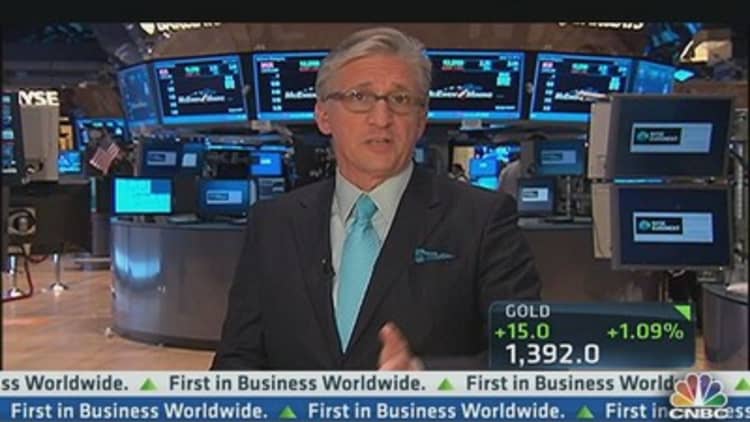If ever there was a low-maintenance retirement plan product, the target-date mutual fund is it.
Tailor-made for those who prefer to put their investment portfolios on autopilot, such funds automatically adjust their asset mixes to become more conservative as investors approach retirement age.
Assets held in target-date funds, also called life-cycle or age-based funds, crossed the $500 billion threshold in 2013, according to fund tracker Morningstar. Demand for such products, especially among 401(k) plan participants, shows no signs of slowing, according to financial experts.
Asset-management consulting firm Casey, Quirk & Associates forecasts that target-date funds will represent nearly half of the projected $7.7 trillion in U.S. defined contribution assets by 2020.
(Watch: Protecting your portfolio against volatility)
While target-date funds may make long-term investing easy, the products themselves are anything but simple, said Jeremy Stempien, director of investments for Morningstar's Investment Management division.
For example, each of the more than 600 existing target-date funds comes with its own fee structure, risk profile and asset mix, making performance measurement against any one index virtually impossible.
"You'd like to be able to look at one 2015 target-date fund versus another, but it's not like comparing two large-cap funds," Stempien said. "They can be much more aggressive or conservative relative to their peers, depending on how they are structured."

Some financial advisors also argue that target-date funds, in addition to being difficult to evaluate, are inherently too generic to meet the needs of individual investors.
"In the context of a 401(k), it's often one of the better hands-off options, but our critique of them is that they are not personalized enough to take preferences into account," said Jon Stein, a financial analyst and CEO of financial advisory firm Betterment LLC.
(Read more: Average 401(k) plan is underfunded)
He notes that investors willing to roll up their sleeves may be able to achieve better returns on their own. Target-date funds "don't account for risk tolerances, and they're not flexible," he said.
It's possible, of course, to purchase target-date funds independently through a broker, but most investors select the one available through their employer-sponsored 401(k) retirement plan.
That makes it all the more critical to weed out funds with excessive fees and determine whether their risk profiles match your own, Stein explained.
Look for low fees: When sizing up target-date funds, your first order of business is to check their expense ratios, according to Stein.
"Look for low fees," said Stein, who noted that 50 basis points (0.50 percent) or less is ideal. "The glide path matters less than fees, because fees are certain to affect your return."
(Read more: The best retirement portfolios)
Financial analytics firm BrightScope reports that the average institutional share class target-date fund expense ratio at year-end 2012 was 70 basis points, or 0.70 percent.
But pressure from lawmakers to shed more light on target-date fund fees, coupled with growing consumer awareness of return erosion, is forcing fund families to gradually lower costs.
(Read more: It's never too early to save for retirement)
The Securities and Exchange Commission and the Labor Department have proposed regulations to increase disclosure of target-date fund fees, their underlying investments and the speed with which their allocation, or glide path, changes over time.
Morningstar, which measures fees with a different yardstick, notes that the asset-weighted average expense ratio for target-date funds stood at 0.91 percent in 2012, down from 0.99 percent in 2011 and 1.04 percent in 2010.
The lowest-cost target-date funds, according to BrightScope, include TIAA-CREF Lifecycle Index, Vanguard Target Retirement and Fidelity Freedom Index.

"To" and "through": Another important distinction between target-date funds concerns the glide path—the formula used to adjust the asset-allocation mix. In what's commonly called a "to" fund, the asset-allocation mix is set to reach its most conservative point at the target retirement date.
By contrast, a so-called "through" fund will continue chasing growth well after you retire.
The resulting blend of stocks, cash and bonds can vastly impact your return.
Generally speaking, "to" plans are more conservative, dialing back their exposure to equities and increasing their cash and bond position dramatically in the last few years before the investor retires.
They are often best suited to those willing to forgo higher returns in exchange for lower risk, and for those who intend to liquidate their fund upon retirement to purchase an annuity, Stempien said.
There is, however, an "opportunity cost"—in other words, the potential benefit you forgo when choosing one option over another—to consider. In this case, investors who become too conservative with their portfolio in the early years of retirement risk outliving their savings.
(Read more: It's time to rebalance your portfolio)
"There's potentially more longevity risk with a 'to' plan," Stempien said. "That's money that could be sitting in your account for 20 or 30 more years, so it needs to continue to grow."
There's also the risk that "to" investors, given their higher allocation to bonds, will be more vulnerable to higher interest rates in coming years, he noted, since most market strategists foresee a rise in rates ahead.
But bond exposure can be relatively high with a conservative "through" plan, too, said Stempien, so he suggests checking the glide path before you buy. (Some 2030 target-date funds, for example, have 60 percent of their portfolio in fixed income, while others of the same vintage may have only 30 percent.)
"Through" plans are typically more aggressive than "to" plans, maintaining a bigger stake in equities long after the target retirement date, advisors say.
Because they continue to invest for growth, they are usually the better bet for those who need to augment their savings or protect against longevity risk. But they also are more volatile, according to Stempien.
"We think 'through' plans are generally better, particularly if you don't plan to take all of your money out at retirement," he said.
Performance: The prudent investor, of course, will also look at a fund's performance record. As a benchmark, Morningstar uses its Lifetime Allocation Index family to measure target-date fund performance in five-year increments, across three risk profiles: aggressive, moderate and conservative.
But Stempien reminds investors that performance is an imperfect guide. That's partly because past performance is never a guarantee of future returns but also because target-date managers often use a retirement-income strategy that does not necessarily seek to outperform the markets but to instead provide stability in the later years.
"The focus on performance, at times, can be overblown," he said. "Many target-date funds are built with a goal to help investors get to a successful retirement."
Thus, he said, many individuals would be better served in a target-date fund with an appropriate asset allocation, rather than a fund that seeks to provide the highest return by assuming greater risk.
Do-it-yourself: Remember, too, that the target-date fund available through your employer may be the only choice in your retirement plan, but it's not your only option.
If the fees for the employer choice are too high or you aren't comfortable with its risk level, you can purchase a target-date fund independently through a broker. Or, if you're willing to assume a greater degree of involvement in your investments, you can build your own portfolio to reflect your ideal glide path.
Investors who are 45 or younger, said Betterment's Stein, might get better returns with a mix of low-cost, long-term equity funds (or index funds) and low-cost bond funds, rebalancing every five years to reflect their changing risk tolerance and time horizon (i.e., how long they want to hold the investment).
"When you're in your 40s, 90 percent of a target-date fund's allocation is in equities anyway," he said.
(Read more: Are you on track for retirement?)
Betterment's model equity portfolio allocates 25 percent to Vanguard Total Stock Market [VTI], 25 percent to iShares S&P 500 Value Index [IVE], 25 percent to Vanguard Europe Pacific [EAFE], 10 percent to Vanguard Emerging Markets [VWO], 8 percent to iShares Russell Midcap Value Index [IWS] and 7 percent to iShares Russell 2000 Value Index [IWN].
Fixed-income exposure for those with a 70-percent stock and 30-percent bond split includes 35 percent in High-Quality U.S. Bonds [], 17 percent in U.S. Corporate Bonds [LQD], 34 percent in High-Quality International Bonds [BNDX] and 14 percent in Emerging Markets Bonds [VWOB].
Building your own portfolio is more legwork, Stein said. However, it's also time well spent if the target-date fund in your 401(k) plan charges 70 basis points.
"If you're saving 50 basis points per year, it's worth it," he said.
Target-date funds may make saving easy, but they can also leave your nest egg a little light if fees erode your return or their glide paths are too conservative early on.
Financial advisors agree that a little research on the front end will tell you everything you need to know about expense ratios, investment philosophy and asset mix—including whether it makes more sense to go rogue.
—By Shelly K. Schwartz, Special to CNBC.com




